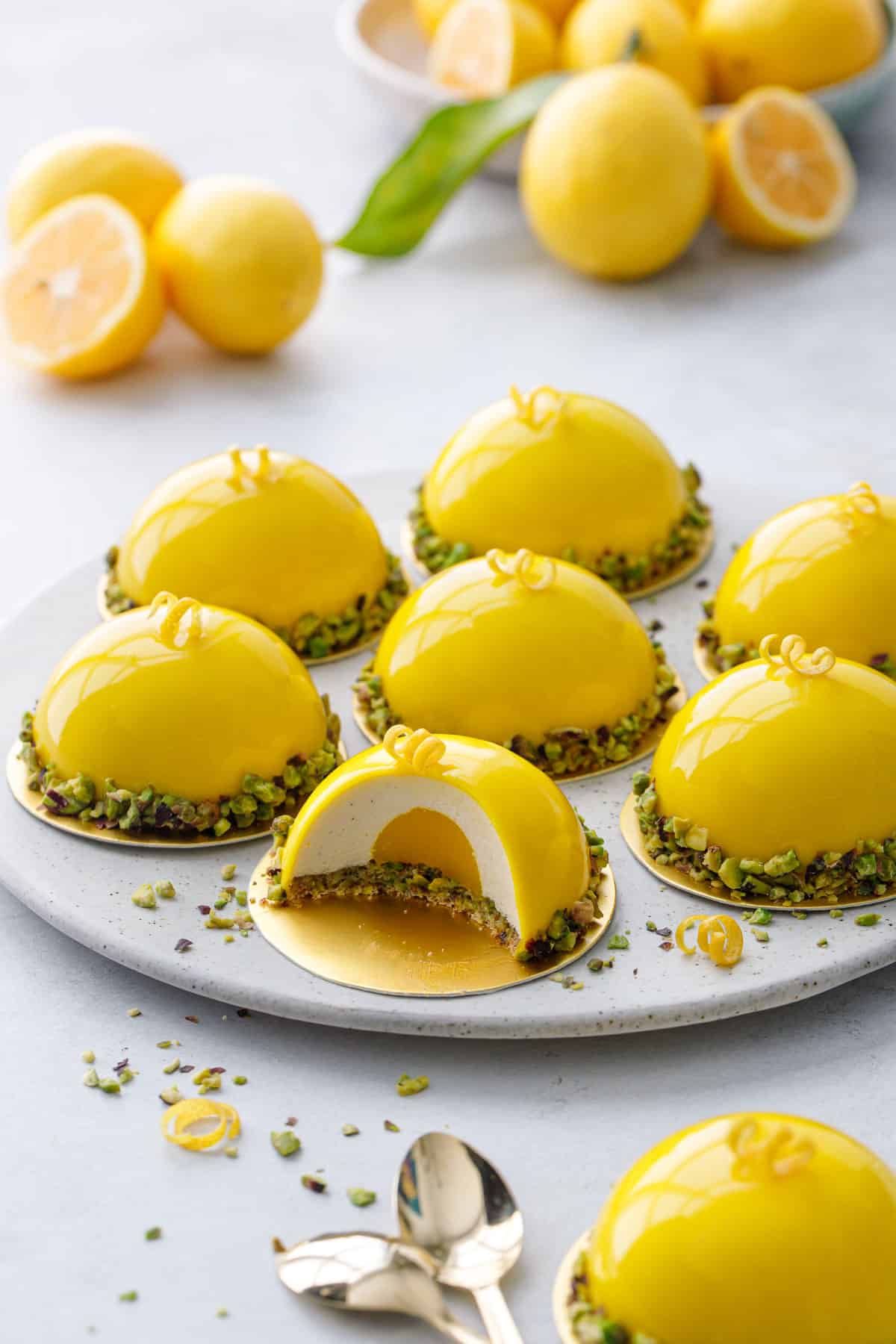Bake for 8 minutes or until the tops of the cookies are just set but still soft. Remove from oven and use a round cookie cutter (one size larger than you used to trace the circles) to ‘swirl’ around the edges of the soft meringue until you can see the edge of the pencil marks. Do this quickly while they are still hot and pliable. If your cookies are already too crisp to reshape, you can use the exact size cookie cutter to cut off the edges to make your rounds the size they
need to be. Note that if you do this the cookies will deflate and will be quite a bit flatter in the end.
Return pan to oven and bake for another 25 to 35 minutes more, or until tops are crispy and ever so lightly browned. Thicker rounds may need up to 40 minutes to completely dry out. Turn off oven, crack the oven door and let the cookies cool down in the warm oven which will help them dry out even further.
To make the lemon vanilla mousse:
Cut gelatin into 1-inch strips and submerge in cool water to soften.
In a bowl, whisk together egg yolks and granulated sugar until lightened.
Warm cream, milk, sugar, vanilla, and lemon zest in a saucepan over medium heat until it starts to steam. Slowly ladle into egg yolks, whisking constantly,
until most of cream has been incorporated and mixture is warmed through. Return to saucepan and cook over low heat, stirring frequently, until it thickens and coats the back of the spoon (will measure 165 degrees F on an instant read thermometer).
Wring out water from softened gelatin and add to warm custard; whisk until smooth. Run through a fine mesh sieve to remove zest and any solid bits; let
cool for at least 15 minutes until lukewarm.
In a clean bowl or the bowl of a stand mixer, beat heavy cream until it holds soft peaks (do not over-beat). Add ⅓ of whipped cream to the cooled custard and fold to lighten, then add the remaining cream and fold until fully incorporated.
To assemble:
To assemble your cakes, spoon or pipe the mousse into 2½-inch silicone dome molds, not quite all the way full. Gently press a lemon dome, curved side down, into the top of each mousse-filled mold. If you find your lemon domes are sinking, let the mousse chill in the molds for 15 minutes or so to firm it up just a tiny bit.
Finally, top with round of pistachio dacquoise, pressing lightly just until the mousse starts to pop out the sides. Place on a flat cookie sheet and place in the freezer so it is level; freeze for at least 3 hours or overnight until set solid.
Before you make the glaze, remove cakes from molds and invert (dacquoise side down) on a frozen cookie sheet lined with parchment paper. Return to freezer until just before glazing.
Make the mirror glaze:
Cut gelatin into 1-inch strips and submerge in cool water for at least 5 minutes to soften. Place white chocolate in a heat-proof bowl and set aside.
Combine sugar, corn syrup, and water in a saucepan and bring to a boil over medium heat until sugar is completely dissolved and mixture is clear.
Remove from heat, then add gelatin (squeeze out as much water as possible first) and whisk until dissolved. Whisk in sweetened condensed milk. Pour hot mixture over chopped white chocolate and let sit for 30 seconds, then stir until chocolate is completely melted and mixture is smooth (you can also use an immersion blender if you have one to expedite this process, just try not to mix air bubbles into the glaze if possible).
Add powder or gel food coloring as desired. You can also divide your glaze up into multiple colors and then swirl them if you’d like.
Let glaze cool, stirring occasionally, until glaze reaches approximately 85 to 90 degrees F on an instant-read thermometer. The glaze needs to be the correct temperature: too warm and it will not form a thick enough layer on the outside of the cakes; too cool and it will not flow smoothly.
Remove cakes from freezer and place on a cookie sheet, elevated off the sheet using small jars or cookie cutters (ideally something smaller in diameter than the cake itself so the glaze can drip off). You can also put them on a wire rack. If you have more than 6 or 8 individual cakes, I recommend working in two batches. You can always rewarm the glaze if it gets too cool (do so gently over a double boiler or in very short intervals in the microwave).
Pour glaze generously over cakes, taking care to ensure there are no bare spots left. Allow the excess glaze to drip off for 5 or 10 minutes, then gently
scrape the edges to remove any remaining drops. Carefully transfer cakes using a small offset spatula to cardboard cake rounds or small pieces of parchment paper for easy movement. Any leftover glaze can be scraped up and refrigerated in an airtight container for later use.
Use a small spoon to coat the bottom edges with chopped pistachios, tapping off excess. Garnish with a lemon twist, if desired.
Glazed cakes will keep in the refrigerator for up to 3 days. Let come to room temperature before serving.
Notes
* To substitute powdered gelatin, use 1 teaspoon of powdered gelatin per 1 sheet of leaf gelatin called for in this recipe. Instead of softening the gelatin in cold water and then wringing it out, you’ll need to sprinkle the gelatin over a few tablespoons of cool water to allow it to soften, then add the whole mixture to the hot liquid to dissolve.
ADVERTISEMENT

